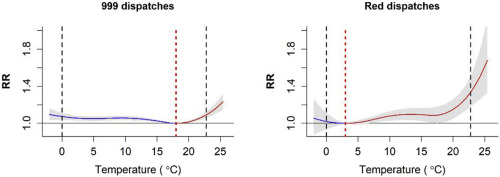当前位置:
X-MOL 学术
›
Environ. Res.
›
论文详情
Our official English website, www.x-mol.net, welcomes your
feedback! (Note: you will need to create a separate account there.)
Impact of extreme temperatures on ambulance dispatches in London, UK.
Environmental Research ( IF 7.7 ) Pub Date : 2020-01-03 , DOI: 10.1016/j.envres.2019.109100 Kamolrat Sangkharat 1 , Marliyyah A Mahmood 1 , John E Thornes 2 , Paul A Fisher 3 , Francis D Pope 1
Environmental Research ( IF 7.7 ) Pub Date : 2020-01-03 , DOI: 10.1016/j.envres.2019.109100 Kamolrat Sangkharat 1 , Marliyyah A Mahmood 1 , John E Thornes 2 , Paul A Fisher 3 , Francis D Pope 1
Affiliation

|
BACKGROUND
Associations between extreme temperatures and health outcomes, such as mortality and morbidity, are often observed. However, relatively little research has investigated the role of extreme temperatures upon ambulance dispatches.
METHODS
A time series analysis using London Ambulance Service (LAS) incident data (2010-2014), consisting of 5,252,375 dispatches was conducted. A generalized linear model (GLM) with a quasi-likelihood Poisson regression was applied to analyse the associations between ambulance dispatches and temperature. The 99th (22.8°C) and 1st (0.0°C) percentiles of temperature were defined as extreme high and low temperature. Fourteen categories of ambulance dispatches were investigated, grouped into 'respiratory' (asthma, dyspnoea, respiratory chest infection, respiratory arrest and chronic obstructive pulmonary disease), 'cardiovascular' (cardiac arrest, chest pain, cardiac chest pain RCI, cardiac arrhythmia and other cardiac problems) and 'other' non-cardiorespiratory (dizzy, alcohol related, vomiting and 'generally unwell') categories. The effects of long-term trends, seasonality, day of the week, public holidays and air pollution were controlled for in the GLM. The lag effect of temperature was also investigated. The threshold temperatures for each category were identified and a distributed lag non-linear model (DLNM) was reported using relative risk (RR) values at 95% confidence intervals.
RESULTS
Many dispatch categories show significant associations with extreme temperature. Total calls from 999 dispatches and 'generally unwell' dispatch category show significant RRs at both low and high temperatures. Most respiratory categories (asthma, dyspnoea and RCI) have significant RRs at low temperatures represented by with estimated RRs ranging from 1.392 (95%CI: 1.161-1.699) for asthma to 2.075 (95%CI: 1.673-2.574) for RCI. The RRs for all other non-cardiorespiratory dispatches were often significant for high temperatures ranging from 1.280 (95% CI: 1.128-1.454) for 'generally unwell' to 1.985 (95%CI: 1.422-2.773) for alcohol-related. For the cardiovascular group, only chest pain dispatches reported a significant RR at high temperatures.
CONCLUSIONS
Ambulance dispatches can be associated with extreme temperatures, dependent on the dispatch category. It is recommended that meteorological factors are factored into ambulance forecast models and warning systems, allowing for improvements in ambulance and general health service efficiency.
中文翻译:

极端温度对英国伦敦的救护车调度的影响。
背景技术经常观察到极端温度与健康结果之间的关联,例如死亡率和发病率。但是,相对较少的研究调查了极端温度在救护车派遣时的作用。方法使用伦敦救护车服务(LAS)事件数据(2010-2014年)进行时间序列分析,该事件数据包括5,252,375次调度。应用具有拟似然泊松回归的广义线性模型(GLM)分析救护车调度与温度之间的关联。将温度的第99个(22.8°C)和第一个(0.0°C)百分位定义为极端高温和低温。调查了14种类型的救护车派遣,分为“呼吸道”(哮喘,呼吸困难,呼吸道胸部感染,呼吸骤停和慢性阻塞性肺疾病),“心血管”(心脏骤停,胸痛,心胸痛RCI,心律不齐和其他心脏问题)和“其他”非心肺呼吸(头晕,与酒精有关,呕吐和“通常不适”) )类别。GLM中控制了长期趋势,季节性,星期几,公共假日和空气污染的影响。还研究了温度的滞后效应。确定每个类别的阈值温度,并使用相对风险(RR)值以95%置信区间报告分布式滞后非线性模型(DLNM)。结果许多调度类别显示与极端温度显着相关。来自999个派遣的呼叫总数,“通常不舒服” 调度类别在低温和高温下均显示出显着的RR。大多数呼吸类别(哮喘,呼吸困难和RCI)在低温下均具有明显的RR,其估计RR范围从哮喘的1.392(95%CI:1.161-1.699)到RCI的2.075(95%CI:1.673-2.574)。对于所有其他非心肺呼吸派遣来说,RR的高温通常很明显,从“一般不适”的1.280(95%CI:1.128-1.454)到与酒精相关的1.985(95%CI:1.422-2.773)。对于心血管组,只有胸痛报告在高温下具有明显的RR。结论取决于调度类别,救护车调度可能与极端温度相关。建议将气象因素纳入救护车预测模型和预警系统,
更新日期:2020-01-04
中文翻译:

极端温度对英国伦敦的救护车调度的影响。
背景技术经常观察到极端温度与健康结果之间的关联,例如死亡率和发病率。但是,相对较少的研究调查了极端温度在救护车派遣时的作用。方法使用伦敦救护车服务(LAS)事件数据(2010-2014年)进行时间序列分析,该事件数据包括5,252,375次调度。应用具有拟似然泊松回归的广义线性模型(GLM)分析救护车调度与温度之间的关联。将温度的第99个(22.8°C)和第一个(0.0°C)百分位定义为极端高温和低温。调查了14种类型的救护车派遣,分为“呼吸道”(哮喘,呼吸困难,呼吸道胸部感染,呼吸骤停和慢性阻塞性肺疾病),“心血管”(心脏骤停,胸痛,心胸痛RCI,心律不齐和其他心脏问题)和“其他”非心肺呼吸(头晕,与酒精有关,呕吐和“通常不适”) )类别。GLM中控制了长期趋势,季节性,星期几,公共假日和空气污染的影响。还研究了温度的滞后效应。确定每个类别的阈值温度,并使用相对风险(RR)值以95%置信区间报告分布式滞后非线性模型(DLNM)。结果许多调度类别显示与极端温度显着相关。来自999个派遣的呼叫总数,“通常不舒服” 调度类别在低温和高温下均显示出显着的RR。大多数呼吸类别(哮喘,呼吸困难和RCI)在低温下均具有明显的RR,其估计RR范围从哮喘的1.392(95%CI:1.161-1.699)到RCI的2.075(95%CI:1.673-2.574)。对于所有其他非心肺呼吸派遣来说,RR的高温通常很明显,从“一般不适”的1.280(95%CI:1.128-1.454)到与酒精相关的1.985(95%CI:1.422-2.773)。对于心血管组,只有胸痛报告在高温下具有明显的RR。结论取决于调度类别,救护车调度可能与极端温度相关。建议将气象因素纳入救护车预测模型和预警系统,









































 京公网安备 11010802027423号
京公网安备 11010802027423号